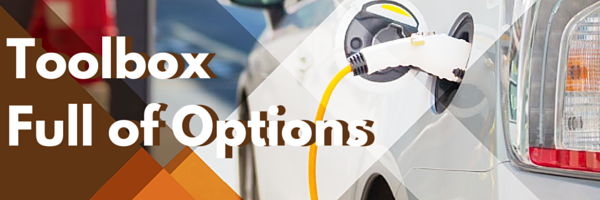A World Without Carbon Pollution – Closer Than You Might Think
For many, a world without carbon pollution seems like a distant utopia. To some, this even seems unobtainable. The size and scope of the challenge before us can be daunting, yet, there is good news -- a world without carbon pollution is closer than you think.
For many, a world without carbon pollution seems like a distant utopia. To some, this even seems unobtainable. The size and scope of the challenge before us can be daunting, yet, there is good news — a world without carbon pollution is closer than you think.
Yesterday, our friends at Frontier Group released a great new report entitled, A New Way Forward – Envisioning a World Without Carbon Pollution. The report makes the case that the tools we need to successfully combat carbon pollution already exist, and if we make smart choices over the next few decades, we can potentially reduce our carbon emissions by 90 percent by 2050. That’s enough to meet the promises of the Paris agreement, which calls for an 80 percent reduction of greenhouse gas (GHG) emissions by mid century in order to avoid the worst impacts of climate change.1
Accomplishing this vital goal will require a complete transformation of our current transportation system. The truth is, there is no path to effectively combat climate change that does not address emissions from transportation. Transportation sector emissions currently account for about 26 percent of the nation’s GHG emissions and 4 percent of the world’s emissions.2 In fact, America’s transportation system alone produces more global warming pollution than the entire economy of any other nation in the world, apart from China, India, or Russia.3
What’s more concerning is that greenhouse gas pollution isn’t just an environmental problem; it’s a public health problem as well. According to a study from researchers with Duke University and NASA, a 75 percent reduction in emissions from transportation could save 120,000 lives by 2030 and another 14,000 lives every year thereafter.4 An MIT study estimates that we are already losing 200,000 lives prematurely from air pollution each year, and 53,000 of those are attributable to transportation activities.5
This is a reality we do not need and cannot afford to accept.

Fortunately, there are already a variety of tools in our toolbox that can drastically reduce our carbon footprint today. Electrification of vehicles, increased use of shared-mobility services, more and better public transportation, greater transit-oriented development, safe and walkable neighborhoods, and smart pricing for roads and parking — these options are already available and would make a huge impact. According to the report, states and localities that employ multiple different approaches can create “win-win-win” outcomes where the “transition to low-carbon vehicles and fuels, reduced growth in vehicle travel, and improved system efficiency” occur simultaneously in order transform the emissions landscape.
So where should localities start? As the report makes clear, there is no single path forward. Each community poses unique challenges and requires unique solutions. There is no one-size-fits-all approach, but there is an approach to fit all sizes.
What’s key, is that the tools in the toolbox work best when paired with each other. Electrification of just over half of the nation’s vehicles has the potential to decrease carbon emissions by 50-60 percent.6 Current public transit systems have already resulted in a 10 percent reduction in emissions, and further investment could increase ridership and reduce global warming pollution further.7 Safe, walkable neighborhoods centered around transit stations could further reduce emissions by 9-15 percent.8 And smart pricing that charges drivers by the mile rather than a continued reliance on the gas tax could reduce emissions by another 12-15 percent below a business as usual scenario.9 These numbers add up quickly when tools are paired with each other to create a cohesive, multipronged approach.

However, it is unlikely that we will make meaningful progress unless we start by taking action today. As the old saying goes, what gets measured gets managed, and right now, states aren’t measuring the impact transportation projects are having on emissions or considering the impacts of proposed transportation projects for future emissions. This is bad for public health and bad for the environment.
Fortunately, there is an opportunity to remedy that situation. The Obama administration is currently considering new rules that would require states to set targets for reducing their carbon emissions, measure and track their progress, and publicly report their results. You can support a carbon emissions standard by submitting a comment right now.
This is a necessary first step that must be implemented, but it will not be sufficient on its own.
To truly make a difference, states will need to set ambitious emissions-reduction targets and breakaway from the antiquated mindset that attempts to address transportation problems with perpetual spending on new and wider highways. This flawed approach cannibalizes scarce resources that would be better used to build a truly multimodal transportation network focused on moving people efficiently, rather than just cars. Setting clear targets for emissions reduction and measuring our results is a great way to encourage states to employ the tools already in their toolbox and is a thus a key step in creating a zero-carbon transportation system.
1 Fact Sheet: U.S. Reports its 2025 Emissions Target to the UNFCCC, The White House, March 31, 2015.
2Greenhouse Gas Inventory Data Explorer, U.S. Environmental Protection Agency, April 30, 2015.
3 Tony Dutzik and Alana Miller, A New Way Forward: Envisioning a Transportation System Without Carbon Pollution, Frontier Group, May 24, 2016.
4 Drew T. Shindell et al., “Climate and health impacts of US emissions reductions consistent with 2°C,” Nature Climate Change, February 22, 2016.
5 F. Caiazzo et al, “Air pollution and early deaths in the United States. Part I: Quantifying the impact of major sectors in 2005,” Atmospheric Environmental Journal, May 31, 2013.
6Environmental Assessment of a Full Electric Transportation Portfolio, Electric Power Research Institute and Natural Resources Defense Council, September 17, 2015.
7 Frank Gallivan et al., Quantifying Transit’s Impact on GHG Emissions and Energy Use – The Land Use Component, Transportation Research Board of the National Academies, 2015.
8Moving Cooler: An Analysis of Transportation Strategies for Reducing Greenhouse Gas Emissions, Urban Land Institute, July 2009.
9Reinventing Fire: Transportation Sector, Rocky Mountain Institute, October 2011.

